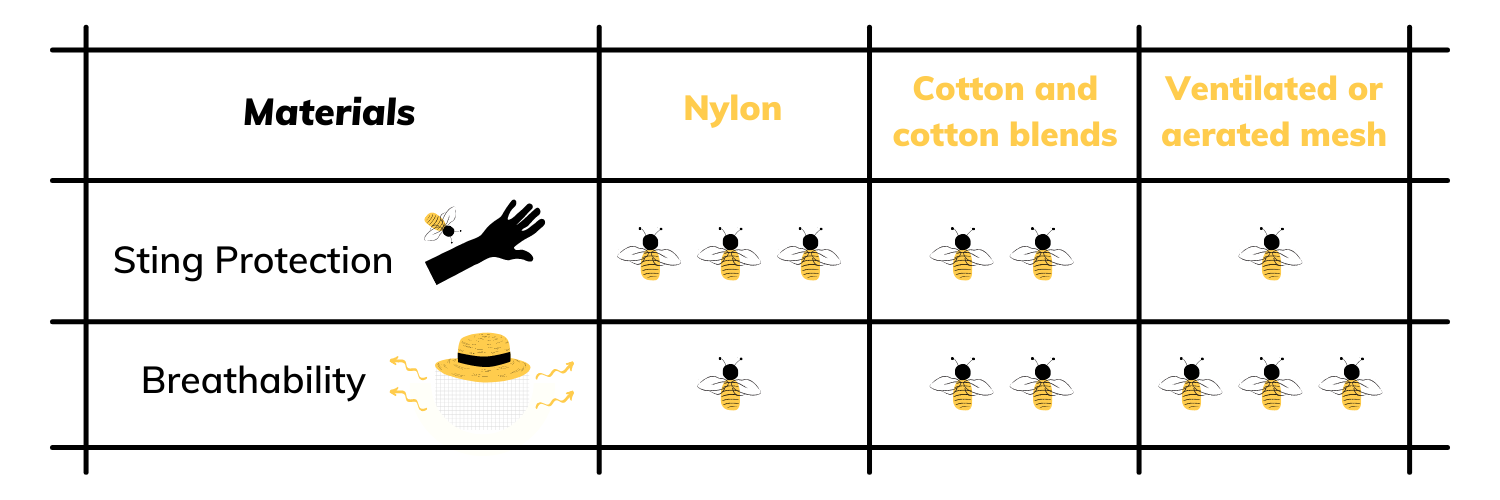For beginners, the most difficult part of choosing a bee suit is completeness. How do you know you have everything you need? I understand the struggle as a transitioning beginner myself. I’ve also found that a top-to-bottom approach helps. This guide explains everything you’ll ever need from head to toe.
I’ll talk about the options available per body part, choosing the right size, and the pros and cons of different materials.
This article on choosing a bee suit is broken down into the 4 general areas that need protection: Head, torso/body, hands, and feet.
Table of Contents
Is a bee suit necessary?
Honey bees are generally docile creatures and they prefer not to sting. Having a bee suit is arguable. But for most beginners, if not virtually all, having a bee suit is necessary. At least that’s how I see it.
Wearing a bee suit inspires confidence, and confidence leads to calmness. A calm beekeeper is less likely to get stung. That’s the simple yet honest reason. If you’re calm, your bees are calm.
Related: 8 Effective Ways to Avoid Bee Stings as a Beginner Beekeeper (Ranked)
So maybe just wear a veil if the summer heat makes you nervous. But for most people, particularly beginners, knowing you’re less likely going to get stung is encouraging.
Hat and veil (head)
There are two things you need to consider when selecting protective gear for your head. The first is whether or not you choose a hat and veil that are attached or separated. And the other is the shape of your headgear.
The 3 veil shapes available are the round veil, the fencing veil, and the square veil.
All options will have their tradeoffs. For instance, fencing veils will have somewhat distracting lines that impede your vision. Whether or not the distraction is tolerable or not will depend on the beekeeper, unfortunately. If at all possible, test before you buy. (In fact, this applies to all options mentioned here. Try before you buy.)
Separated vs. attached hat and veil
The main advantage of a separated veil is the ability to replace it when torn. You also get to choose a hat that you like. But separated hat and veil combinations might also leave a few gaps for the bees to get into.
With an attached hat and veil, the seal is a relief. There are fewer things to worry about, and that makes it the most common option for beginners.
Round vs fencing vs square
Round veil
This is what a round veil looks like.
The main advantage of a round veil is its field of view. It’s basically a round hat with a veil on the sides, and that means an unbroken line of sight.
A potential disadvantage is the hat’s fit. If it’s too loose, then it could occasionally fall when bending over or looking up. This is unlike the fencing veil.
Fencing veil
Remember those fencing helmets worn in the Olympics? This is precisely what you may have imagined a fencing veil for beekeeping looks like.
A fencing veil stays upright regardless of your movements. Plus it usually stays away from your head, reducing the risk of getting stung. (Maybe wear a cap inside to keep the veil from getting close to your face.)

The lines though can be distracting for some. Not that it isn’t serviceable. But compared to the round veil, vision is definitely reduced, even by just a bit.
Square or folding veil
Another option is the square or folding veil. It’s great because it folds away easily. But like the fencing veil, the field of view can be an issue.
Quality of veil
Another concern to think about is the grain size of the veil. As a rule of thumb, the finer the mesh, the easier it is to see through.
There hasn’t been any glaring difference to me, but it is worth considering if you have poor eyesight. The more expensive ones probably make it easier to see a bit better.
Jacket or suit (torso or body)
When choosing a bee suit, you can pick between getting protection for your entire body or projection for just your torso (with a jacket).
My preference is for the full bee suit. Regardless of the materials used (which we’ll talk about in a bit), a bee suit is designed to prevent bee stings from reaching your skin. Now, there’s no such thing as a sting-proof suit, and accidents will happen. But wearing a suit that’s designed specifically for a purpose will probably do a better job.
And yes, bee stings go through jeans.
Here’s the difference between a jacket and a suit:
Materials used
The most popular materials are nylon, cotton & cotton blends like polycotton, and ventilated or aerated mesh.
When choosing the material used for your suit, there’s a tradeoff between sting protection and breathability.
Here’s my rating system for sting protection and breathability, on a scale of 1 star to 3 stars, with 3 stars as the best.

Nylon
Sting protection: 3 stars
Breathability: 1 star
Nylon is slippery and will offer the best protection from bee stings. It is also impermeable and very hot during the summer. If you live in a place with bearable summers and long winters, nylon can be a good choice.
Cotton and cotton blends
Sting protection: 2 stars
Breathability: 2 stars
Traditional bee suits were made of cotton and cotton blends. Polycotton, a blend of cotton and polyester, is also often used as a material for bee suits.
Recent advancements have been introduced and, depending on your needs, you’re probably better off getting nylon or ventilated bee suits. That said, cotton suits also tend to be cheaper, making them a viable option for some.
Ventilated or aerated mesh
Sting protection: 1 star
Breathability: 3 stars
At the other end of the spectrum, ventilated bee suits offer the most in terms of breathability. These are typically 3 layers of mesh to prevent bee stings. They sufficiently protect beekeepers from bee stings but, compared to the other 2 options, will have the least protection. (But “least” doesn’t mean no protection.)
For beekeepers working in places with extremely hot summers, ventilated bee suits are the preferred choice.
Zipper vs. velcro vs. strings
Choosing a bee suit with zipper, velcro, or strings is again a tradeoff — this time of sting protection and cost. A zipper will give you more protection because it ensures there aren’t any gaps. Strings are at the other end of the spectrum, but they are cheaper.
Color
Many beekeepers will tell you that the color of your suit will have to be white. That’s not necessarily true.
White is a factor, because of the honey bees’ evolutionary tendency to attack bear-like colors, but ultimately they know we’re not bears.
If you want to be absolutely sure, wear the color white. It’s sort of a tiebreaker. (Read this article for an in-depth look at your color choice: Why Are Bee Suits White? Evolution, NASA, and Tipping Points) But a bee suit does not have to be white.
Do you like standing out? Check out this ventilated/aerated yellow bee suit on Amazon:
Sizing
As a rule-of-thumb, wear a bee suit that’s one size bigger than your regular size. Don’t worry about going overboard either. Lots of beekeepers buy as large as two sizes up!
Clearly-sustainable.com has a fantastic sizing chart for bee suits.
Gloves (hands)
There’s a tradeoff with gloves, but you probably already noticed this by now — there are reasons for the variety of choices.
With gloves, you’ll have to choose between bee sting protection and dexterity.
But this one’s tricky. If you’re clumsy because of your thick leather gloves, then you’ll likely annoy the bees more and have them sting you. But if you choose dexterity and go with the thin nitrile or dishwashing ones, then there’s not much protection for your hands.
Some beekeepers even swear by the no-gloves approach. But again, because of the confidence it inspires, I’d recommend gloves for beginners. Just understand that it’s a balance between protection and dexterity.
Boots (feet)
There are ways to avoid bees coming up your trousers, such as avoiding the front of the hive. (Because bees shoot out of the bee hive like a rocket, it’s best not to stand in front anyway.) But these aren’t guaranteed to keep bees out.
The last thing you want is a curious bee trapped inside your pants!
Some bee suits come with elastics on both legs and hands, while others don’t. Maybe wedge the suit inside of highcut boots for added protection.
Conclusion
Choosing a bee suit will depend on your location, persona & priorities, and budget. There are a variety of types, colors, and materials to choose from — each with distinct advantages and disadvantages. It’s no surprise then that there’s no such thing as the universal best bee suit. And that’s a good thing because it means there are plenty of options to choose from. There’s a bee suit to fit every type of beekeeper possible.
*This post may contain affiliate links. You can read my affiliate disclosure here, Terms & Conditions, #6 Links.

Honey Farm Starter documents our journey from novices to (hopefully) experts. If you’re feeling a bit intimated by all big words and don’t know where to start, this place is for you. We are Dan & Deanne, and our hope is to create a resource that’s as encouraging as possible for the everyday backyard beekeeper.

